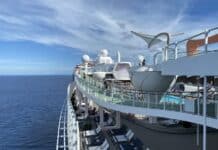For years, cruises have been known as a cheap getaway — somewhat to the chagrin of the cruise companies. While low fares may draw passengers in, more revenue makes investors and cruise executives happy.

Before the pause in cruising due to the pandemic and during the ramp-up in return afterward, inexpensive cruises were abundant.
It wasn’t unusual to find fares well below $100 a day and many times below $50 per day for some cruises. In fact, we sailed aboard a Carnival cruise in August 2022 for just $14 per day in cruise fare.
Those days, however, seem to be gone for the foreseeable future. Soaring demand has given cruise companies the ability to push prices higher, while the public’s appetite for cruising shows no signs of slowing.
Historically Strong Demand for Cruises Leads to Record Bookings
For years, cruise companies have made the point that a cruise vacation is a tremendous value compared to a typical vacation on land. Passengers get room, board, entertainment and transportation all together in one package that’s considerably lower than purchasing all these parts separate.
This value is something that’s drawn passengers to ships, but also that cruise lines saw as an opportunity to raise prices.
“Cruising remains an exceptional value proposition with strong demographics and secular tailwinds, allowing us to outperform the broader leisure travel industry,” Royal Caribbean Group CEO Jason Liberty said during a recent earnings call.
“Our goal is to further narrow the gap to land-based vacations as we attract even more satisfied customers to our vacation ecosystem.”
That seems to be working. Currently, cruise companies seemingly across the board are seeing record interest and demand.
Carnival Corporation announced in early 2024 that it experienced “an early and robust start to wave season.” Wave season is the period of time around the start of the year when there is traditionally stronger demand to book cruises.
“For 2024, the Company continues to have the best booked position on record, with both pricing (in constant currency) and occupancy considerably higher than 2023 levels. In fact, the first half of 2024 is almost fully booked,” a press release said.
Cruise rival Royal Caribbean Group is seeing similar momentum. The company just announced its full-year earnings for 2023, along with an update on current bookings.
“Overall, the five best booking weeks of the company’s history have occurred since the last earnings call, including the first three weeks of WAVE,” the company stated in a press release. “As a result, the company is now in a record booked position in both rate and volume.”
It then continued, saying, “consumer spending onboard and pre-cruise purchases continue to exceed prior years driven by greater participation at higher prices, indicating quality and healthy future demand.”
Higher Prices As Demand Soars, Limiting Cheap Deals

What’s surprising is that this record demand is also coming at a time of higher prices for cruises overall.
For example, in 2023, Royal Caribbean Group earned total passenger ticket revenue of $9.57 billion, with 49.5 passenger cruise days over the entire year. That comes out to an average daily fare of $193.10.
In 2022, however, when cruises were still ramping up following a return to service, fares were considerably lower. At that time, the cruise company reported ticket revenue of $5.79 billion with 35.0 million passenger cruise days. That meant an average daily fare of $165.27.
Carnival Corporation enjoyed ticket revenue of $14.1 billion in 2023 with 91.4 million passenger cruise days. That’s an average daily fare of $153.91.
In 2022, when cheaper fares were more abundant, the cruise company saw ticket revenue of $7.0 billion with 54.6 million passenger cruise days, or just $128.61 in average daily fare per person.
And even though fares have rebounded, so too have occupancy rates, indicating consumers have no issue paying more to set sail:
Overall inflation has some to do with this jump in cruise fares. In addition, the lines are also using higher revenue to shore up balance sheets following the pandemic. During the pause in cruising, the companies took on massive debt loads to survive.
For instance, Norwegian Cruise Line Holdings Ltd. — parent of NCL and other lines — saw its debt load soar from about $7 billion in 2019 to nearly $14 billion today. Royal Caribbean Group saw debt move from about $11 billion in 2019 to roughly $20 billion today. And Carnival Corporation saw debt go from roughly $11 billion before the pause to about $30 billion today.
With the return to cruising, the companies have worked to use that higher revenue to retire debt, strengthening their positions.
How You Can Still Save Money on Cruises
With high demand showing no signs of abating and full ships with record bookings, there’s little reason for cruise lines to cut fares. The higher prices look to be more of the rule than the exception at this point.
If you want to save, what can you do? There are still some tried and true steps you can take to cruise for less. And yes, there are some inexpensive deals out there, but they seem to be fewer in number.
Sail When School Is in Session: If sailing the Caribbean or Bahamas, a simple rule of thumb is to sail when school is in session. During this time, it’s more difficult for families to sail, which make up a large portion of demand for major lines. As a result, fares tend to be lower overall compared to peak times like summer.
Look to Sail on Older Ships: Cruise ships continue to evolve with each new vessel seeming to be a little bigger, better, and more expensive to build. As a result, lines put a premium on newer ships.
For instance, a trip in an interior room aboard Royal Caribbean’s Icon of the Seas starts at $3,419 per person for a July 27, 2024 sailing. A trip aboard Wonder of the Seas (the cruise line’s next newest ship after Icon) starts at just $1,479 per person for a sailing the same weekend. That’s less than half the cost.
Be Open to Cruise Lines: If you are married to one cruise line, it severely limits your ability to find cheaper fares. After all, you’re stuck paying whatever the line charges. Instead, opening up your options to more lines means you have the ability to potentially find trips sailing for cheaper.













